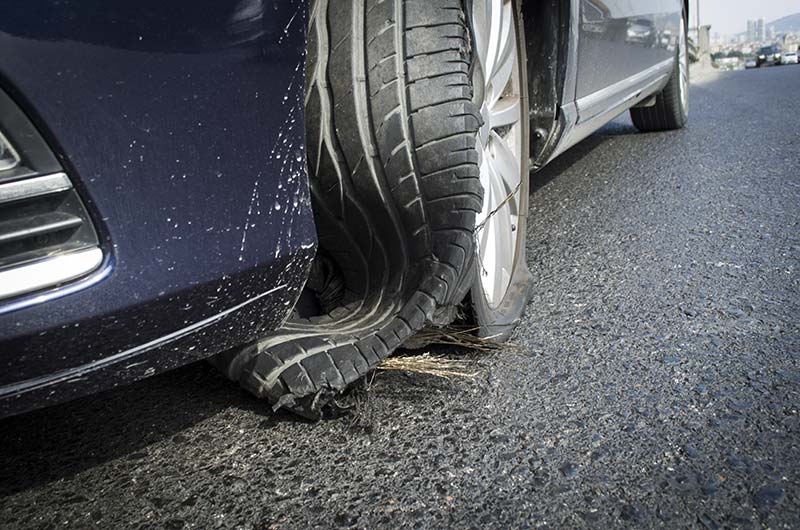
Potholes, broken pavement, inadequate drainage, and poorly maintained traffic signals can lead to serious accidents and injuries. If you were involved in an accident due to dangerous road conditions in California, you may wonder if you can sue the city for potholes. The short answer is yes, but pursuing a lawsuit against the city for poor roads presents unique challenges.
Government Responsibility for Road Maintenance in California
In California, public entities—including state, county, and municipal governments—are legally responsible for maintaining roads and highways in a reasonably safe condition for motorists, cyclists, and pedestrians.
This duty is codified in California Government Code Section 835, which establishes the circumstances under which a government entity can be held liable for injuries caused by a dangerous condition on public property.
Under this statute, you can take legal action for road damage-related accidents and injuries if the following elements are met:
The Condition Posed a Foreseeable Risk of Injury
- The road defect or hazard must create an unreasonable danger for lawful users of the road. This could include potholes, uneven pavement, missing guardrails, obscured traffic signs, poor drainage leading to hydroplaning, and improperly maintained road construction zones.
- The condition must be one that a reasonable person would recognize as hazardous.
- Foreseeability is an essential element in this analysis. Evidence of prior incidents of a similar nature arising from the same road defect or hazard may provide good evidence of foreseeability.
The Government had Notice of the Condition and Failed to Address It in a Reasonable Time
- Actual notice means the government was directly informed about the hazardous condition. This could occur through citizen complaints, accident reports, or prior lawsuits related to the same issue.
- Constructive notice means that, even if the government wasn’t explicitly informed, it should have known about the defect through routine inspections or maintenance obligations.
- If the hazardous condition existed for a long enough period that proper maintenance practices would have detected and repaired it, the government can still be held responsible.
Government Immunity and Exceptions
Although California law allows injury claims against public entities, government agencies often invoke sovereign immunity defenses to avoid liability. Common defenses include:
- Design Immunity (Government Code Section 830.6): If the dangerous road condition resulted from an approved roadway design, the government may argue that it’s immune from liability. However, this defense does not apply if the design was outdated, inherently unsafe, or improperly implemented.
- Reasonable Time to Fix: Even if the government was aware of the defect, it may claim that it did not have enough time to conduct repairs before the accident occurred.
How to Pursue a Claim Against a California City or Municipality for a Road-Related Accident?
Unlike personal injury lawsuits against private individuals or businesses, legal claims against government entities in California must follow strict procedural requirements.
Filing an Administrative Claim First
Under California Government Code Section 911.2, an injured party must first file an administrative claim with the responsible government agency before pursuing a lawsuit in court. This claim serves as a formal notice to the government and must be submitted within six (6) months of the date of the accident. Failure to comply with this requirement may forever bar the claim, and defeat an ensuing lawsuit, regardless of its merits.

Important details about the administrative claim:
- It must be filed with the city, county, or state agency responsible for the roadway where the accident occurred. This can be a challenge. You can go online for information on where to file a governmental claim and must verify with the office where you plan on filing the claim, that you have the correct and accurate filing location.
- Keep in mind that there may be more than one governmental entity responsible for a given stretch of public property. For example, a city and/or county may have designed and/or constructed the public property, yet the state (ie. CalTrans) may be responsible for the operation and maintenance of the property.
- If unsure, you may want to file the claim separately with multiple different agencies who you believe may be involved, so as to protect the filing deadline.
- Because this is a time-sensitive procedure, you should send your claim form and supporting paperwork through a delivery-date documented mechanism, such as FedEx, Certified Mail-Return Receipt Requested, etc…
- The claim should be completed thoroughly, answering each question completely, to include a detailed description of the accident, specifying the date, time, location, injuries sustained, and the hazardous road condition that caused the crash. You should also include as many theories of liability that pertain to the incident. Keep in mind the necessary elements to ultimately prove your case in a court of law. For example, that could include visibility obscurements, traffic signal malfunctions, foreign objects left on the roadway, unsafe curves, bends, dips, or peaks in the roadway, inadequate signage or warnings, lack of safety features, etc…
- A monetary demand amount for compensation should be included, along with a breakdown of damages such as medical expenses, lost wages, property damage, and pain and suffering.
- Supporting evidence, such as photographs of the road hazard, witness statements, accident reports, and medical records, medical bills, property damage documentation, should be attached to strengthen the claim.
If the claim isn’t properly submitted within the six-month deadline, the injured party may lose the right to seek compensation from the government.
Waiting for a Response from the Government
Once the administrative claim is filed, the government agency has 45 days to review and respond.
- If the claim is approved, the government may offer a settlement, which the injured party can either accept or negotiate.
- If the claim is denied, the claimant will receive a written rejection notice. At this point, they have six months from the date of denial to file a lawsuit in civil court. This potentially, is a snare for the unwary. Pushing the governmental claim to the brink of the 6 months filing deadline, adding to that the 45 days for the rejection letter, and then having only 6 more months to file the lawsuit, that yields a lawsuit filing deadline which is less than the 2 year statute of limitations period for filing a lawsuit in California.
- If the government does not respond within 45 days, the claim is considered constructively denied, and the claimant has two years from the date of the accident to file a lawsuit.
Meeting the Burden of Proof in a Lawsuit
Once a lawsuit is filed, the injured party must prove that the government was negligent in maintaining the roadway and that this negligence directly caused the accident and injuries.
Since government agencies raise strong counter arguments—such as claiming design immunity, arguing that the hazard was not dangerous, or alleging comparative fault on the injured party—it’s vital to present a well-documented case with compelling evidence, including the essential prerequisite that the governmental entity had a duty of care, and that they breached that duty, resulting in the accident.
Can You Sue a City for Bad Roads: Why Skilled Legal Representation Matters
Suing a city, county, or state agency for injuries caused by bad road conditions is complex due to the strict deadlines, procedural rules, and government immunity defenses. A knowledgeable personal injury attorney can:
- Ensure the administrative claim is filed correctly and on time.
- Investigate the accident and gather necessary evidence.
- Challenge government immunity defenses.
- Negotiate a fair settlement or take the case to trial if necessary.
Based on a strong proof of negligence, injured victims can pursue compensation under the California Tort Claims Act and hold the city liable for damages, such as current and future medical bills and lost income, and current and future pain and suffering.
Common Dangerous Road Conditions That Lead to Accidents
A city or government agency may be held liable if road hazards posed a reasonably foreseeable risk and caused you to lose control of your vehicle. Poor road conditions leading to personal injury claims may include:
- Potholes and cracked pavement
- Faded or missing traffic signs and signals
- Poorly designed roadways or intersections
- Inadequate lighting
- Defective road signs
- Flooded or poorly drained roads
- Unmarked construction zones
- Dangerous curves, dips, or peaks in the roadway
- Debris or hazards left on the roadway
- Visibility obscurements (ie. overgrown brush, trees, etc…)
- Malfunctioning traffic controls
- Inadequate signage
- Failure to warn
Steps to Take if You’re Injured in an Accident Due to Bad Roads in California
If you’re injured in an accident caused by dangerous road conditions, it’s crucial to act quickly and take the necessary steps to protect your rights. Here’s a step-by-step guide on what to do:
Seek Medical Attention Immediately
- Your health and safety are the top priority. Even if your injuries seem minor, you should seek medical evaluation, as some injuries can worsen over time.
- Keep medical records, doctor’s notes, and hospital bills, as they serve as important evidence in your claim.
Document the Road Hazard and Accident Scene
- Take clear photographs and videos of the hazardous road condition (e.g., potholes, broken pavement, uneven surfaces, missing signs, poor lighting, or debris).
- Capture multiple angles and include nearby landmarks or street signs to show the exact location of the hazard.
- If possible, take pictures of your vehicle damage and visible injuries.
Call Law Enforcement and File an Official Report
- Dial 911 and request that law enforcement come to the scene.
- If the police arrive, they will create an accident report, which can be valuable in proving your claim.
- Obtain a copy of the police report, or if no officer responds, file an incident report with the local city or county agency.
Collect Witness Statements and Contact Information
- If other drivers, pedestrians, or local residents witnessed the accident or were aware of the dangerous road conditions, ask for their names, phone numbers, and statements.
- Witness testimony can strengthen your case by corroborating your version of events.
Identify the Government Entity Responsible for the Road
- City or County Governments: Responsible for local streets and roads
- Caltrans (California Department of Transportation): Maintains state highways and freeways
- Federal Agencies: Responsible for certain roads in national parks or military bases
Check for Prior Complaints or Road Maintenance Records
- Look for past complaints, maintenance logs, or reports related to the dangerous road condition.
- If prior complaints exist, they can prove the government had notice of the hazard but failed to act.
- An attorney can help obtain this information through public records requests.
File an Administrative Claim Within Six Months
- Under California Government Code Section 911.2, you must file an administrative claim with the responsible government agency within six months of the accident.
- The claim should include a detailed description of the accident and road hazard, evidence (photos, witness statements, police report, medical bills, repair estimates), and a monetary demand outlining your losses.
- If your claim is denied, you have six months from the denial date to file a lawsuit.
Preserve All Evidence and Avoid Making Statements to Insurers
- Don’t give recorded statements to insurance adjusters without legal advice, as they may use your words against you.
- Keep all receipts, invoices, and communication records related to medical treatment, car repairs, and lost wages.
Hire an Experienced California Personal Injury Attorney
- Suing a government entity involves strict deadlines and complex legal defenses, such as government immunity.
- An attorney can investigate the accident and gather evidence, ensure your claim is filed correctly and on time, negotiate a fair settlement, or take your case to court.
By following these steps, you can strengthen your claim and improve your chances of receiving fair compensation for your injuries caused by dangerous road conditions in California.

How Our Personal Injury Lawyers Prove the Municipality’s Liability
When filing a claim against a city or municipality for injuries caused by dangerous road conditions, comprehensive evidence is key to proving liability and recovering full compensation. At The Law Offices of Rosenstock and Azran, our experienced personal injury attorneys thoroughly investigate your case and collect every piece of critical evidence necessary to build a strong claim.
Photographic and Video Evidence
Clear visual proof is essential in demonstrating the hazardous road condition that led to your accident. Our legal team gathers high-resolution photographs and videos of potholes, uneven pavement, missing guardrails, faded lane markings, or other dangerous road defects.
We may also use dashcam footage, drone imaging, and surveillance recordings from nearby traffic or security cameras to further establish the severity of the hazard.
Accident Reports and Official Documentation
Official accident reports provide key details that help support your claim. We obtain police reports, California Highway Patrol incident reports, and municipal accident records, which often include officer observations, statements from involved parties, and preliminary assessments of the road condition.
Road Maintenance Records and Prior Complaints
To prove negligence, we investigate whether the city had prior knowledge of the road defect. Our team secures public maintenance logs, repair work orders, city inspection reports, and prior complaints from residents or drivers who reported the dangerous condition. If the city failed to address a known hazard, this strengthens the case.
Eyewitness Testimonies and Expert Analysis
Testimonies from witnesses who saw your accident or are familiar with recurring road issues can be valuable in establishing negligence. We also collaborate with accident reconstruction specialists, traffic engineers, and civil engineers to analyze the defective road and confirm how it contributed to the crash.
Vehicle Damage and Mechanical Expert Reports
A thorough vehicle damage inspection can provide insight into how the accident occurred. Our car accident attorneys work with auto body experts and forensic mechanics to examine your vehicle and determine how the road defect or the city’s road construction projects contributed to the crash.
Medical Records and Financial Documentation
Our team collects medical reports, hospital bills, rehabilitation records, and pharmacy receipts to document the full extent of your injuries. We also gather pay stubs, employment records, and expert economic analyses to quantify lost wages and future financial losses.
At The Law Offices of Rosenstock and Azran, we’ll leave no stone unturned to prove the city’s liability and recover the largest possible financial compensation for your injuries and losses. To schedule your free consultation, call us at (818) 805 0422 or contact us online.










